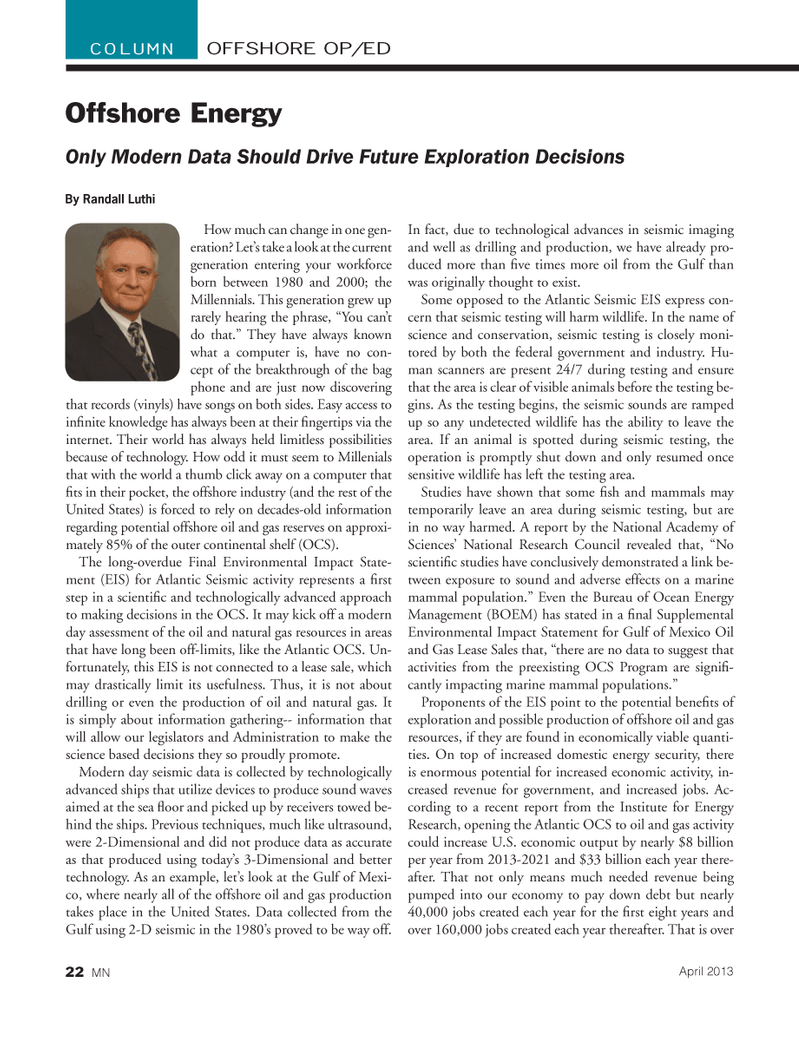
Page 22: of Marine News Magazine (April 2013)
Offshore Service Operators
Read this page in Pdf, Flash or Html5 edition of April 2013 Marine News Magazine
How much can change in one gen- eration? Let?s take a look at the current generation entering your workforce born between 1980 and 2000; the Millennials. This generation grew up rarely hearing the phrase, ?You can?t do that.? They have always known what a computer is, have no con- cept of the breakthrough of the bag phone and are just now discovering that records (vinyls) have songs on both sides. Easy access to in nite knowledge has always been at their ngertips via the internet. Their world has always held limitless possibilities because of technology. How odd it must seem to Millenials that with the world a thumb click away on a computer that ts in their pocket, the offshore industry (and the rest of the United States) is forced to rely on decades-old information regarding potential offshore oil and gas reserves on approxi- mately 85% of the outer continental shelf (OCS). The long-overdue Final Environmental Impact State- ment (EIS) for Atlantic Seismic activity represents a rst step in a scienti c and technologically advanced approach to making decisions in the OCS. It may kick off a modern day assessment of the oil and natural gas resources in areas that have long been off-limits, like the Atlantic OCS. Un- fortunately, this EIS is not connected to a lease sale, which may drastically limit its usefulness. Thus, it is not about drilling or even the production of oil and natural gas. It is simply about information gathering-- information that will allow our legislators and Administration to make the science based decisions they so proudly promote. Modern day seismic data is collected by technologically advanced ships that utilize devices to produce sound waves aimed at the sea oor and picked up by receivers towed be- hind the ships. Previous techniques, much like ultrasound, were 2-Dimensional and did not produce data as accurate as that produced using today?s 3-Dimensional and better technology. As an example, let?s look at the Gulf of Mexi- co, where nearly all of the offshore oil and gas production takes place in the United States. Data collected from the Gulf using 2-D seismic in the 1980?s proved to be way off. In fact, due to technological advances in seismic imaging and well as drilling and production, we have already pro- duced more than ve times more oil from the Gulf than was originally thought to exist.Some opposed to the Atlantic Seismic EIS express con- cern that seismic testing will harm wildlife. In the name of science and conservation, seismic testing is closely moni- tored by both the federal government and industry. Hu- man scanners are present 24/7 during testing and ensure that the area is clear of visible animals before the testing be- gins. As the testing begins, the seismic sounds are ramped up so any undetected wildlife has the ability to leave the area. If an animal is spotted during seismic testing, the operation is promptly shut down and only resumed once sensitive wildlife has left the testing area. Studies have shown that some sh and mammals may temporarily leave an area during seismic testing, but are in no way harmed. A report by the National Academy of Sciences? National Research Council revealed that, ?No scienti c studies have conclusively demonstrated a link be- tween exposure to sound and adverse effects on a marine mammal population.? Even the Bureau of Ocean Energy Management (BOEM) has stated in a nal Supplemental Environmental Impact Statement for Gulf of Mexico Oil and Gas Lease Sales that, ?there are no data to suggest that activities from the preexisting OCS Program are signi -cantly impacting marine mammal populations.? Proponents of the EIS point to the potential bene ts of exploration and possible production of offshore oil and gas resources, if they are found in economically viable quanti- ties. On top of increased domestic energy security, there is enormous potential for increased economic activity, in- creased revenue for government, and increased jobs. Ac- cording to a recent report from the Institute for Energy Research, opening the Atlantic OCS to oil and gas activity could increase U.S. economic output by nearly $8 billion per year from 2013-2021 and $33 billion each year there- after. That not only means much needed revenue being pumped into our economy to pay down debt but nearly 40,000 jobs created each year for the rst eight years and over 160,000 jobs created each year thereafter. That is over Offshore Energy Only Modern Data Should Drive Future Exploration Decisions By Randall LuthiOFFSHORE OP/EDCOLUMN22 MNApril 2013MN April2013 Layout 18-31.indd 22MN April2013 Layout 18-31.indd 224/1/2013 11:30:00 AM4/1/2013 11:30:00 AM

 21
21

 23
23
